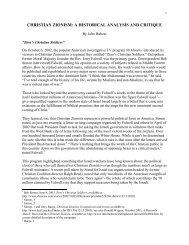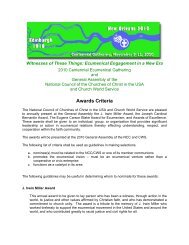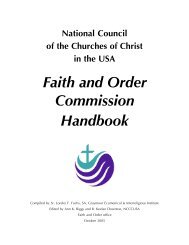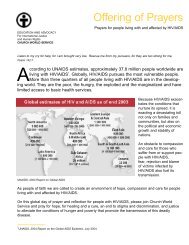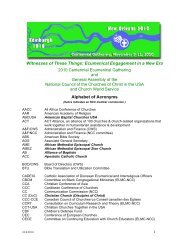Common Agreement on Mutual Recognition of Baptism - National ...
Common Agreement on Mutual Recognition of Baptism - National ...
Common Agreement on Mutual Recognition of Baptism - National ...
You also want an ePaper? Increase the reach of your titles
YUMPU automatically turns print PDFs into web optimized ePapers that Google loves.
810<br />
811<br />
812<br />
813<br />
814<br />
815<br />
816<br />
817<br />
818<br />
819<br />
820<br />
821<br />
822<br />
823<br />
824<br />
825<br />
826<br />
827<br />
828<br />
829<br />
830<br />
831<br />
832<br />
833<br />
834<br />
835<br />
836<br />
837<br />
838<br />
839<br />
840<br />
841<br />
842<br />
843<br />
844<br />
845<br />
846<br />
847<br />
848<br />
849<br />
850<br />
theology and practice in the West in two ways: first, his argument for infant baptism based <strong>on</strong> the<br />
need to be cleansed <strong>of</strong> original sin led to an emphasis <strong>on</strong> early infant baptism as the norm (De<br />
peccatorum merities er remissi<strong>on</strong>e et de baptismo parvulorum and De spiritu et littera) Sec<strong>on</strong>d,<br />
his argument with the D<strong>on</strong>atists over the practice <strong>of</strong> rebaptism led to a focus <strong>on</strong> the sacramental<br />
elements (water, wine, bread) and their objective validity apart from the moral character <strong>of</strong> the<br />
<strong>on</strong>e administering them (C<strong>on</strong>tra epistulam Parmeniani, PL 43) As a result, medieval Western<br />
baptismal practice included baptizing infants as so<strong>on</strong> as possible, the permissi<strong>on</strong> for any<strong>on</strong>e to<br />
baptize (not <strong>on</strong>ly a priest), and a focus <strong>on</strong> the validity <strong>of</strong> the sacrament rather than the extended<br />
drama <strong>of</strong> the fourth century rites.<br />
The baptismal rite for infants in the medieval era became in essence a compressed<br />
versi<strong>on</strong> <strong>of</strong> the rite for adults. Godparents or ministers resp<strong>on</strong>ded to the questi<strong>on</strong>s <strong>on</strong> behalf <strong>of</strong> the<br />
children who could not do so themselves. The rituals <strong>of</strong> handing over the creed and the Lord‘s<br />
Prayer eventually were eliminated, while other elements <strong>of</strong> the fourth century rites (admissi<strong>on</strong> to<br />
the catechumenate, exorcisms, administrati<strong>on</strong> <strong>of</strong> salt and the clothing with the white garment)<br />
remained, but adapted for use with an infant. Other elements <strong>of</strong> the baptismal rites were<br />
reinterpreted. The timing <strong>of</strong> baptism also shifted; though Easter and Pentecost had been the<br />
preferred occasi<strong>on</strong>s for baptism in the fourth century, the emphasis <strong>on</strong> baptizing infants as so<strong>on</strong><br />
as possible led to the practice <strong>of</strong> administering baptism within a few days <strong>of</strong> an infant‘s birth, no<br />
matter the seas<strong>on</strong> <strong>of</strong> the year. Gregory the Great (540-604 C.E.) even allows for a single<br />
immersi<strong>on</strong> <strong>of</strong> adult or child in water, accompanied by the Trinitarian formula (Epist.1.43). By the<br />
eighth century, the Missale Gothicum, [260] called for the use <strong>of</strong> a declarative baptismal<br />
formula, taken from Mt. 28.19-20, marking a definitive end to the previous questi<strong>on</strong> and answer<br />
style <strong>of</strong> the Latin fathers.<br />
A final significant development in baptismal rites in the West was the separati<strong>on</strong> <strong>of</strong> three<br />
liturgical acts: baptism, the anointing that came to be known as c<strong>on</strong>firmati<strong>on</strong>, and first<br />
communi<strong>on</strong>. Once the post-baptismal anointing became a sacrament reserved for the bishop, it<br />
was comm<strong>on</strong>ly celebrated at a time separated—sometimes by several years—from the water<br />
baptism. This rite <strong>of</strong> c<strong>on</strong>firmati<strong>on</strong> was interpreted differently by writers in the medieval period,<br />
but gradually came to be associated with the giving <strong>of</strong> the Holy Spirit. Though the rite <strong>of</strong><br />
c<strong>on</strong>firmati<strong>on</strong> was celebrated as a separate sacrament, however, priests c<strong>on</strong>tinued to anoint the<br />
baptized with chrism immediately following water baptism, symbolizing participati<strong>on</strong> in the<br />
royal and priestly anointing <strong>of</strong> Christ. The timing <strong>of</strong> first communi<strong>on</strong> varied c<strong>on</strong>siderably: in the<br />
early medieval period it was usually given at the time <strong>of</strong> baptism, but in the eleventh century first<br />
communi<strong>on</strong> was usually postp<strong>on</strong>ed until age seven or later, because <strong>of</strong> increasing reverence for<br />
the sacramental species. In 1281, the Archbishop <strong>of</strong> Canterbury, John Peckham, insisted that no<br />
<strong>on</strong>e should come to communi<strong>on</strong> until they had been c<strong>on</strong>firmed, while in Spain and southern Gaul<br />
for a time the unity <strong>of</strong> the three rites <strong>of</strong> initiati<strong>on</strong> was preserved in their original order (see<br />
C<strong>on</strong>cilia Magnae Britanniae et Hiberniae II: C<strong>on</strong>stiuti<strong>on</strong>es Peckham, p. 54).<br />
At the dawn <strong>of</strong> the sixteenth century, though there was not absolutely uniform practice in<br />
the Western church, a comm<strong>on</strong> baptismal order looked like this:<br />
Sarum Rite <strong>of</strong> <strong>Baptism</strong> (1543)<br />
20



